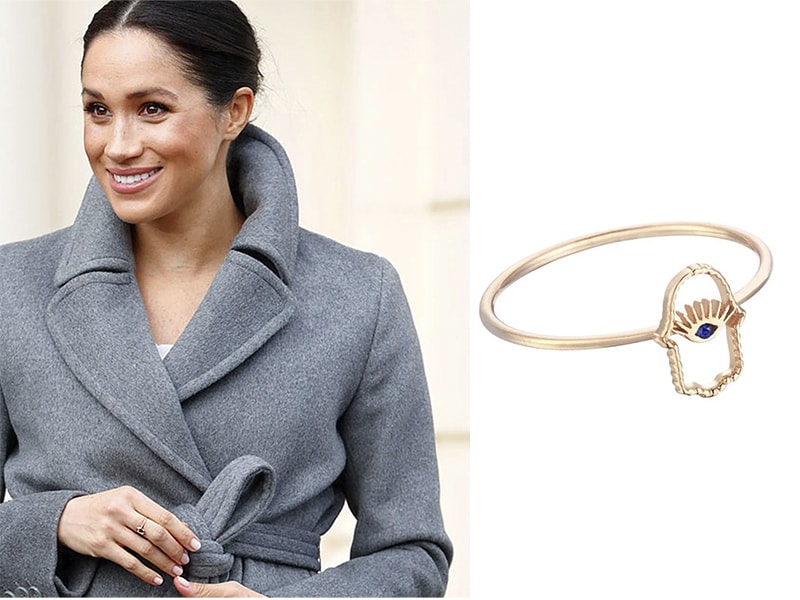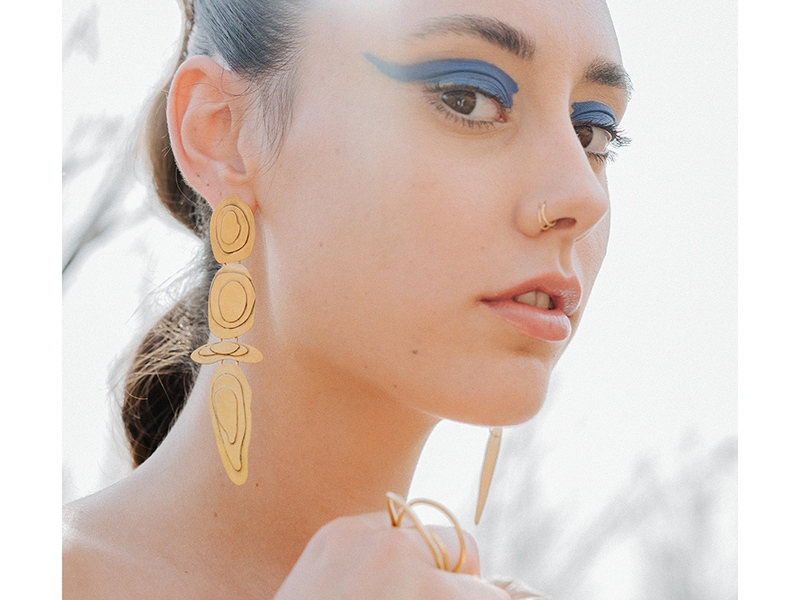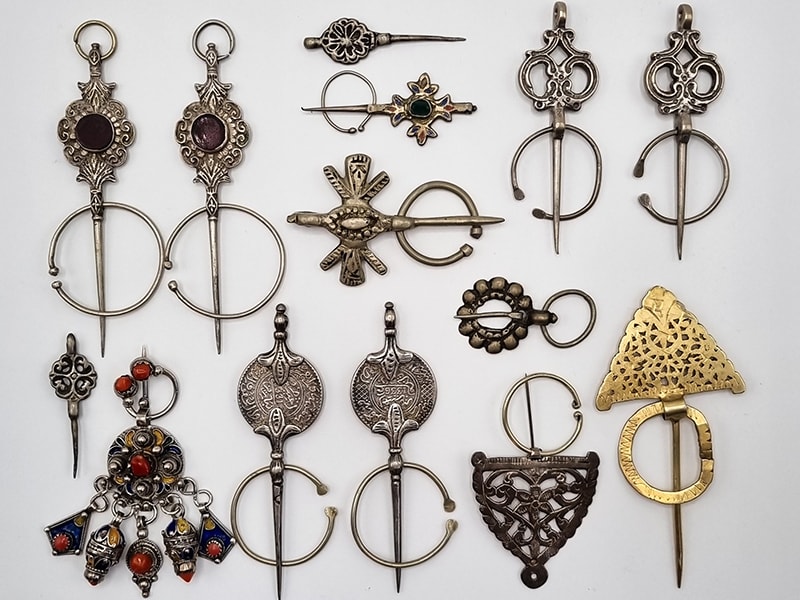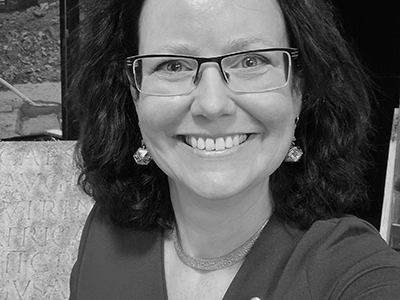When Meghan, Duchess of Sussex, stepped out in 2018 for an event with the Royal Variety Charity, she wore a dainty rose gold ring. It had a stylized Hand of Fatima with a bright blue eye in its center. Its designer: Kismet by Milka, a Turkish brand. But wait. Designer? After all, jewelry in the shape of a hand is available everywhere. Your local corner shop may even carry a few, as keychains or lucky charms. This form has been in use in the Middle East for thousands of years. So how is this “design”?

As a region, Southwest Asia and North Africa (SWANA) is home to many cultures, peoples, languages, and religions. These share a long history, but they are not one and the same. All use some forms, like the Hand of Fatima. Other forms are particular to one culture. Throughout this vast region, jewelry designers favor “traditional” forms we’re familiar with: evil eye beads, hands, coin pendants.
Why are these designs so popular? Is there nothing new and exciting coming from SWANA? If you have been secretly asking yourself that question, you’re not alone. But here’s the thing: it’s the wrong question to ask.
Let’s explore that idea of design. In the West, we feel design should be original. Design should be innovative and progressive. Designers create jewelry with a message. A strong design can contribute to activism and challenge existing norms. Just think of Madeleine Albright’s pins. Another example is Dutch designer Eva van Kempen, whose Planned Parenthood creations speak for women’s rights when it comes to abortion. We are used to jewelry designs that take us out of our comfort zone. They make us stop and reflect and, like Albright’s pins, they tell everyone around us what we think. Make no mistake: the SWANA world has many of those innovative designers, including Mai Zarkawi, LX2 Studio, and Gaelle Khouri, to name but a few.

Jewelry based in older forms is regarded as the opposite of “design.” We think we don’t see the individuality of the artist in it, that we see no originality. We think we see the same form, over and over again. This jewelry is often called “traditional.” That is a problematic word to use.
Vanessa de Gruijter, curator and chair of the Francoise van de Bosch Foundation, writes about non-Western jewelry: “They are oftentimes considered ‘traditional,’ ‘artisanal,’ ‘authentic,’ or ‘spiritual,’ and seen as representative of primitive ways of life, or are imagined to still be produced in some ancient, unchanging way.”[1] That also implies that jewelry like this does not talk like modern, innovative pieces do. But jewelry always expresses ideas. That is what it is made for.
Salma Ahmad Caller, a British/Egyptian artist, points out how arbitrary this definition of design is. “Just look at wedding rings,” she tells me. “The same form copied over and over again, and yet every couple spends hours and hours selecting a set that is just perfect for them. The Hand of Fatima is like that: the form may be the same, yet every piece is different in its details.”
She goes on to add: “And these ‘traditional’ designs themselves change all the time, too. They are not frozen in time. Every period has its own fashion, its own style. And its own trend in motifs.”
Jewelry does not have to be groundbreaking or unique in its design to carry meaning and express ideas. In fact, that is a Western way of looking at design.
Yasmine el-Dorghamy, founder of RAWI, a periodical on Egyptian history, and an adjunct in the design department at American University in Cairo, agrees. “In Egyptian jewelry, ‘design’ was not quite the deliberate act that it is today,” she explains. “People grew up among forms and shapes that they worked into jewelry and other art forms. Jewelry-making was organic and borrowed its motifs from the surrounding visual culture: it was developed a little further every time it was reproduced.”
Caller zooms in on this design process a little more tightly. “In the West, designers are taught to sit down and think first. They come up with an idea that they want to express, and then they think about the form it should take. But in many parts of the world, design is embodied. Your hands make it because the forms are everywhere in your culture, they are in your soul. It is only in the West that we stopped calling that ‘design’ and started using the word ‘crafts’—as if it is not meaningful unless you think about it first. And even then: designers everywhere, whether from East or West, create based on their personal experiences. Their work responds to their own long histories and traditions of how things should look. So while we may use different words like ‘design’ or ‘craft,’ in reality we are all doing the same.”
Looking at the meaning of traditional jewelry patterns from the SWANA world from a Western point of view is problematic. It’s like trying to fit a square peg in a round hole. It just does not fit. And we miss out on what jewelry from the SWANA world and its makers have to tell us.
Contemporary jewelry created in North Africa and Southwest Asia is rooted in personal experiences, is contributing to activism, and is challenging existing norms. It has a lot to share. And it always has shared. Jewelry in the SWANA region was much more than just an ornament. Jewelry was a language. Jewelry was a savings account. Jewelry was a powerful thing to protect oneself from evil and illness. Jewelry was practical: it fastened cloaks and held dresses together. It accompanied women through those stages in life when they got married or became mothers. It shared joy and sorrow, it had a soul. And it expressed identity, of the person as well as of their community. Patterns in jewelry also exist in weaving, basketry, pottery, and much more. Jewelry is always part of its surroundings. It’s part of the very fabric that holds a community together.

All of that is also true for traditional Western jewelry. When you think of it, West and East do the exact same thing. Both use the same designs over and over again (like the wedding rings, or the Hand of Fatima). Both attach meaning to jewelry. Both are home to innovative designers. So how did we (in the West) come to misunderstand jewelry from this part of the world?
The SWANA region was colonized by European countries in the 19th and 20th centuries. This is when many photographs of local women were made. Old postcards show women from SWANA the way Western photographers liked to see them: exotic, bejeweled, and often naked. While their jewelry spoke about pride and identity, Western photographers only saw seduction and ornament. In these photos, the language of jewelry is lost. It’s reduced to a prop, like the women themselves.
And then, from the 1960s onwards, the jewelry itself was massively sold by its owners. It was seen as old-fashioned, and was replaced with more “modern” jewelry. But if it was old-fashioned then, why is it so popular now? What makes SWANA jewelry designers reach for these age-old forms? What do they want to express through them? Ranging from identity on a national level to personal experiences as a person from mixed heritage, jewelry has a lot to tell.

Take the many near-identical copies of jewelry, for example, the ones put on when dressing up for special occasions where traditional jewelry is worn. These are for celebrations like weddings and national holidays.
Folklore groups perform dances dressed in traditional clothing and jewelry, for example. When the performance is over, they change back into their normal clothes and go about their usual routine. Jewelry like this isn’t worn every day. It’s meant to show group identity: “This is what our culture looks like.” Everyone knows this isn’t regular dress. The pieces are similar to traditional jewelry, but often lighter. They are limited to a few variations, instead of the endless variation that traditional jewelry has. “This is more for tourists,” you often hear. But even if that’s the case, apparently this is still the picture tourists should see.
Of course, none of this is exclusive to the SWANA world. Almost every country has its own folklore festivals. Jewelry can also be part of a national image. Dress and adornment of the United Arab Emirates (UAE), for example, is based in Arab and Bedouin styles. The UAE are a young nation, and here dress and adornment communicate a new national identity. In choosing Arab and Bedouin jewelry to illustrate that, they communicate where they place themselves—and who they exclude. The jewelry of the many people of Indian or Baluchi origin in the UAE is not part of the national image.
With this collective fascination for old forms, how do modern jewelry designers use these when they create new pieces? Do they simply copy older examples? El Dorghamy, the founder of the periodical RAWI, is clear about an important distinction. Jewelry created by today’s designers in Egypt is fundamentally different from traditional design. “Traditional jewelry is a long-lost memory,” she says. “No one wears this anymore. What we see are traditional motifs used in new work.” She thinks this might be out of nostalgia, and even a touch of homegrown Orientalism. “Many designers learn about the motifs and designs from books. They did not grow up around them.” In much the same way, these days few Westerners grow up wearing Art Nouveau jewelry, but the forms can be found in books and some artists take inspiration from them. But even when SWANA jewelry designs are not organic but carefully thought out, the old forms continue to show up. That means they are still considered important.
That importance is also the topic of research by Saudi designer Dr. Khadeeja Althagafi. Her PhD explores how to keep age-old cultural connections but give them a modern twist. She writes that Saudi women do not have to choose between “Western modern” or “traditional.” There is a third choice: Jewelry that “reflects their place in a globalized world.” Jewelry that is “not tied to global Western brands.” Jewelry that is “fresh, unique, and distinctly Saudi Arabian.”[2] This jewelry uses old forms on purpose to highlight the identity of the wearer—and notably not as Western.
These old forms are not just important symbolically, but also socially. One example is how they empower women. The work by Turquoise Mountain[3] illustrates this beautifully. Here, both men and women are schooled in the art of silversmithing and other crafts. Turquoise Mountain works in Afghanistan, Jordan, and Myanmar. An initiative of H.R.H. King Charles III when he was still the Prince of Wales, the foundation helps people to create not just jewelry but a living for themselves. Hana Faouri of Turquoise Mountain Jordan explained it to me:
“When you come from a regime where jewelry was forbidden, or when you have fled and left everything behind, pouring your soul in familiar designs is grounding.” The jewelry that these students design is highly personal. It combines both their own ideas and their cultural background. Their jewelry speaks of personal strength and pride in their heritage.
So identity and roots are a fundamental aspect of jewelry based in traditional designs in the region itself. But for many SWANA artists living in other countries, expressing identity is a constant struggle. What does it mean to grow up in Europe but have family in the SWANA region? How do you identify when your roots are in several very different cultures? That’s not an easy position to be in, because how people see themselves is also highly influenced by their social surroundings. What do neighbors and coworkers think, what is written in newspapers about their culture? Jewelry designed by SWANA artists living in other countries speaks about those struggles with cultural identity, roots, and migration. It also addresses issues like social injustice, discrimination, and political opinions.

Caller’s project Making the Postcard Women’s Imaginarium addresses these issues, too. It places the women on those Orientalizing postcards of a century ago in a new context. Jewelry is a natural part of the project. It’s present in her art itself, but also in the exhibition that launched in London on September 22, 2022.[4] Through original jewelry, we learn to look at the Postcard Women with new eyes. We learn to see them as human beings, not as decoration. We learn to read their jewelry to hear their personal stories.
As Caller says, “These jewels and clothes that we see on the postcards have deep meaning in the cultures that they come from. They hold the histories of women, their forms and patterns hold knowledge that women would learn from their mothers and their grandmothers, and that they would tell their daughters in turn. When we look at the Postcard Women, we see ways of life that we remember: not just the jewelry, but also the songs, the poetry, our complicated histories, and our personal stories.” That same un-learning of our usual view on jewelry design is important for understanding modern jewelry by SWANA designers, too.
If we keep focusing on the distinction between traditional and innovative, we miss out. Some artists work with traditional motifs and others with new forms and shapes. But none of them are stuck in the past. Their work talks about a present in which mixed heritage, migration, and displacement clash with racism, colonial stereotypes, and prejudice. It speaks of a present in which old forms are part of their own personal search for identity. Even nostalgia, that rose-colored dream of the past, speaks of the need to identify with a given culture.
The work of jewelry designers can also be a form of activism through art: to break the mold of what others think of them—including Western views. Jewelry design empowers refugees and gives them a voice. For each artist, the reasons behind choosing traditional motifs are different and often personal. But they all have in common that they comment on today’s world, explore their place in it, and give us their opinions. All we need to do is learn to see through their eyes, not ours.
Many thanks to Salma Ahmad Caller and Yasmine El Dorghamy for the time and the thoughts they shared with me on the power of jewelry design.
References
Akinci, I. “Dressing the Nation? Symbolizing Emirati National Identity and Boundaries through National Dress.” Ethnic and Racial Studies 43, no. 10 (2020): 1776–1794.
“Contemporary Muslim artists Continue to Adapt Islamic patterns to Challenge Ideas about Fixed Culture.” Hawzah News Agency. https://en.hawzahnews.com/news/364745/Contemporary-Muslim-artists-continue-to-adapt-Islamic-patterns.
Daleure, G. “Holistic Sustainability Policies: Preserving Local Cultural Identity in the UAE in the Face of Globalisation.” Indian Journal of Public Administration 65, no. 3 (2019): 749–768.
Hosny, Farah. “The Palestinian Jewellery Designer Adorning Gisele, Oprah, and Queen Rania.” Scene Arabia. https://scenearabia.com/Style/Dima-Rashid-Palestinian-Jewellery-Designer.
Turquoise Mountain. “Jordan.” https://www.turquoisemountain.org/Jordan.a
Safak, A. 2021. Acculturation of Syrian Refugees in Turkey and the Netherlands. PhD thesis, Tilburg University.
[1] https://www.current-obsession.com/decolonise-contemporary-jewellery/.
[2] K. Althagafi, The Art of Saudi Contemporary Jewellery: Rejuvenation for a Contemporary World,a 2018. PhD thesis, Australian National University.
[3] https://www.turquoisemountain.org/.
[4] https://www.salmaahmadcaller.com/photography-project-postcards-of-women.





